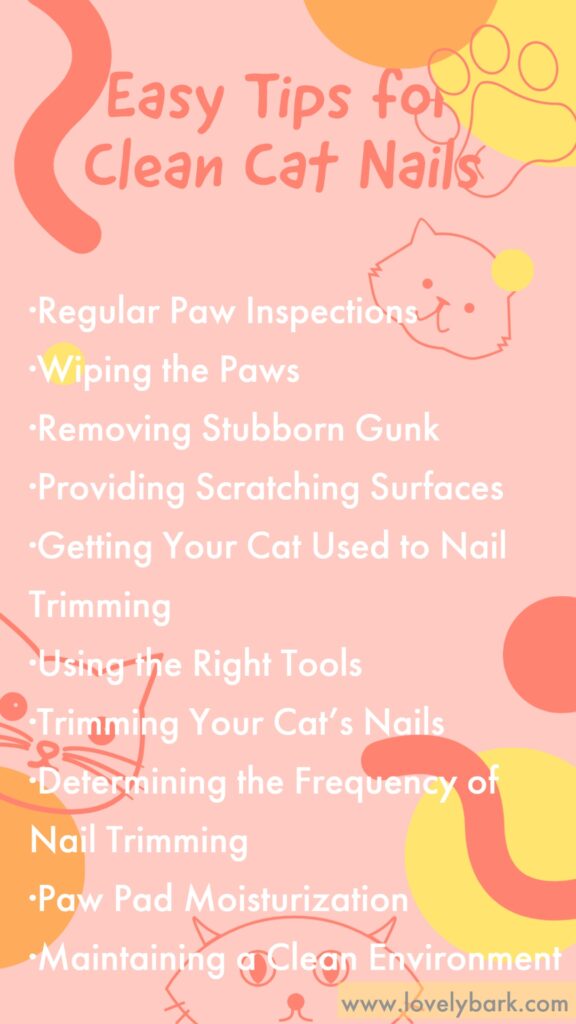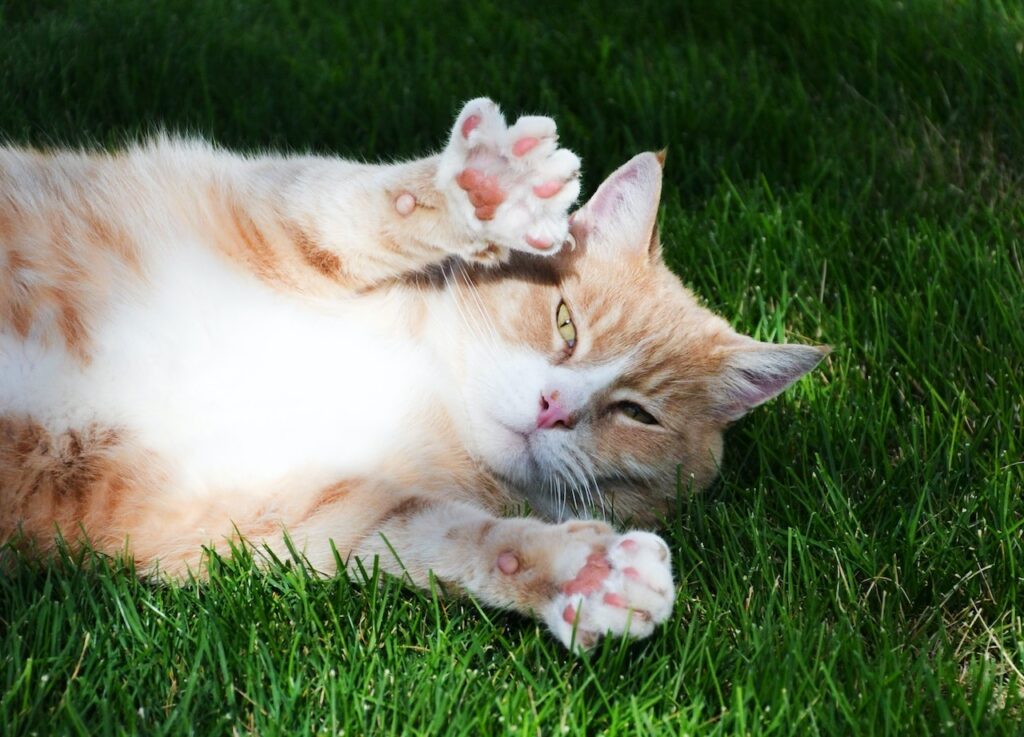Table of Contents
The Importance of Clean Cat Nails
Before we dive into the specifics of cleaning your cat’s nails, let’s understand why it’s important to maintain clean claws. Cats rely on their nails for various activities such as climbing, jumping, hunting, and defending themselves. Over time, dirt, debris, and other substances can accumulate in their nails, leading to discomfort, mobility issues, and even potential infections. Additionally, long and untrimmed nails can curl back into the paw pads, causing pain and making it difficult for your cat to walk properly. By keeping your cat’s nails clean and well-trimmed, you can help prevent these problems and ensure their overall comfort and well-being.
How to Clean Your Cat’s Nails: Step-by-Step Guide
Step 1: Regular Paw Inspections
Start by incorporating regular paw inspections into your cat’s grooming routine. This will allow you to identify any dirt, debris, or potential injuries that may require attention. During your cuddle time with your feline friend, gently examine each paw, including the paw pads and in between the toes. Look out for any signs of injury, cuts, sores, swelling, or redness. If you notice any wounds or minor injuries, clean them with a gentle antiseptic solution to prevent infection. It’s crucial to keep a close eye on your cat’s paws while any wounds are healing.Step 2: Wiping the Paws
To keep your cat’s paws clean on a daily basis, use a damp cloth or baby wipe to wipe each paw thoroughly. Start with one paw at a time, gently wiping away any dirt or debris. Pay special attention to areas between the toes, where debris can easily accumulate. For long-haired cats, it’s important to trim the hair between the paws regularly to prevent dirt and foreign objects from sticking to it while your cat is walking. This simple step can go a long way in maintaining clean and healthy paws for your feline companion.Step 3: Removing Stubborn Gunk
Sometimes, dirt or gunk may be stubbornly stuck in your cat’s nails. In such cases, it’s important to handle their paws with extra care. If you encounter stubborn gunk, you can soak your cat’s paws in warm water for a few minutes to soften it. Then, use a toothbrush or a soft-bristled brush to gently clean the nails, being careful not to apply excessive pressure. For added convenience, you can also use a pet-safe nail cleaner or a specialized cat nail cleaning solution. Remember, always be gentle and patient when removing any gunk, as your cat’s paws are sensitive and require delicate handling.Step 4: Providing Scratching Surfaces
Scratching is a natural behavior for cats, and it serves multiple purposes, including shedding the outer layer of their nails. By providing your cat with appropriate scratching surfaces, you can help them keep their nails clean and well-maintained. Invest in a variety of scratching posts and pads to cater to your cat’s preferences. Place these surfaces strategically throughout your home, making them easily accessible for your cat. Encourage your furry friend to use these designated scratching areas by using positive reinforcement techniques, such as treats or praise. Not only will this help keep their nails clean, but it will also provide them with an outlet to exercise, stretch their muscles, and mark their territory.Step 5: Getting Your Cat Used to Nail Trimming
Trimming your cat’s nails is an essential part of their grooming routine. However, it may require some patience and training to get your cat comfortable with the process. Start by introducing nail trimming as early as possible, preferably when your cat is still a kitten. This will help them become accustomed to the sensation and associate it with positive experiences. Begin by gently massaging your cat’s paws, gradually increasing the duration over time. This will help desensitize them to having their paws handled. Once your cat is comfortable with paw massages, you can gradually introduce the nail trimming process.Step 6: Using the Right Tools
When it comes to trimming your cat’s nails, it’s crucial to use the right tools. Invest in a high-quality pair of cat nail clippers or a specialized nail trimmer designed for cats. Avoid using regular human nail clippers, as they may cause discomfort or injury to your cat. Before trimming, ensure that the clippers or trimmers are clean and sharp to prevent any pain or splitting of the nails. If you’re unsure about the correct technique, consult your veterinarian or a professional groomer for guidance. They can demonstrate the proper way to trim your cat’s nails to avoid cutting into the quick, which can be painful for your cat.Step 7: Trimming Your Cat’s Nails
When you’re ready to trim your cat’s nails, choose a quiet and calm environment to minimize distractions and stress. Gently hold your cat’s paw and press on the pad to extend the nails. Carefully observe the nails and identify the translucent area called the quick. It’s important to avoid cutting into the quick, as it contains blood vessels and nerves. Position the clippers or trimmers slightly above the quick and make a quick, clean cut. Trim only the sharp tip of the nail, leaving a safe distance from the quick. If you accidentally trim into the quick and cause bleeding, apply gentle pressure with a clean cloth or use styptic powder to stop the bleeding. AKC highlights some of the tips for cat nail trimming.Step 8: Determining the Frequency of Nail Trimming
The frequency of nail trimming will vary depending on your cat’s lifestyle and individual needs. Cats that spend more time outdoors, walking on rough surfaces, or using scratching posts regularly may naturally wear down their nails to some extent. However, it’s still important to monitor their nail length and trim as needed. On average, trimming your cat’s nails every 2-4 weeks is a good starting point. However, observe your cat’s nails regularly and adjust the frequency based on their growth rate and condition. If you’re unsure about the optimal trimming schedule, consult your veterinarian for personalized advice.Step 9: Paw Pad Moisturization
Just like humans, cats can experience dry or cracked paw pads. To keep their paw pads healthy and moisturized, you can use a veterinarian-approved paw butter or balm. During your grooming sessions, gently apply a small amount of the moisturizer to your cat’s paw pads and massage it in. This will help soothe and protect their paw pads from dryness and potential cracking. However, if you notice severe irritation, swelling, or any signs of infection, it’s important to consult your veterinarian for proper diagnosis and treatment.Step 10: Maintaining a Clean Environment
In addition to regular paw inspections and nail care, maintaining a clean environment for your cat is crucial for their overall health and hygiene. Keep your floors clean and free from dirt, debris, and harmful substances that can stick to your cat’s paws. Regularly clean and disinfect litter boxes to prevent any potential infections or odor buildup. Use pet-friendly cleaning products and avoid using toxic chemicals that can harm your cat if ingested. By ensuring a clean and safe environment, you’re providing your cat with the best conditions for maintaining clean and healthy paws.
Conclusion
Keeping your cat’s nails clean and healthy is an essential part of their overall grooming routine. By following these easy tips and techniques, you can ensure that your cat’s paws remain clean, their nails are properly trimmed, and their comfort and well-being are prioritized. Remember to be patient, gentle, and consistent during the grooming process, and always reward your cat with treats, praise, or playtime to create positive associations. If you have any concerns about your cat’s nail care or if you’re unsure about any aspect of the grooming process, don’t hesitate to consult your veterinarian for guidance. With regular care and attention, your cat’s paws will stay clean, healthy, and ready for all their feline adventures.”FAQs”
How do you get cat nail caps off ?
Once the nail caps are applied, they remain in place for approximately 4-6 weeks. They will fall off with the natural growth of your cat's nails. We recommend that you check your cat's nails periodically because usually just one or two fall off at a time, and these can easily be reapplied.
How long do cat nails grow ?
Cats' nails will generally grow back within two to three months if they have been clipped or damaged. However, the time it takes for a cat's nails to grow back can vary depending on several factors, including the cat's age, health, and nutrition.
When to trim cat nails ?
Starting nail trims as soon as 6-8 weeks of age is recommended to get them used to the procedure, even if you're only able to do one paw at a time. Start slow, offer breaks, and give them a high value treat with every nail trim: think feline greenies or other treats or canned cat food.
When to cut cat nails ?
There are a few signs your cat's claws are too long: they might catch them on things such as blankets or carpets. you can see them clearly when your cat is resting. they struggle to scratch their claws (because they are too long and painful)
How often do you cut cat nails ?
Trimming a cat's claws every two to three weeks is an important part of maintaining your pet's health. Not only does a quick trim protect you, your pet and your family, it can also save your sofa, curtains and other furniture.
How to trim cat nails at home ?
Swaddle the cat in a towel, keeping the towel close to its torso and only leaving one claw unwrapped at a time. Two people may trim a cat's nails by having one apply pressure towards the back of the ear using with their hands in a V-shape. This should relax the cat while the other person trims the nails.
How far to cut cat nails ?
It's where all the nerves and blood vessels are so it's important to NOT cut into the quick to avoid causing pain and risking infection. Clip one nail (no more than 1/16th of an inch), give her a treat, and take a break. If you do accidentally clip through the quick
How to cut cat nails without hurting them ?
Take one of your cat's paws in your hand and gently press on the pad until you see their claw clearly. If the claw needs a trim, cut only the sharp point and make sure to avoid the quick. Once you've trimmed that nail, immediately release the paw and give your cat a reward if they've noticed what you're doing.
How to deal with cat nails ?
With the proper clippers, clip the very tip of the claw. Don't cut them too short as you could hurt your cat. Avoid the quick at the base of the claw by the toes – this is the bit that will look pink. If you cut this, it will be very painful for your cat and will make them bleed.
How cut cat nails ?
Pets hate getting the quick cut - it's painful! - and it's messy since it can bleed. It's easier to see with light-colored nails than dark-colored nails. If your cat has dark nails, proceed with caution and cut the claws in several stages to reduce the chance of nicking that sensitive area.


